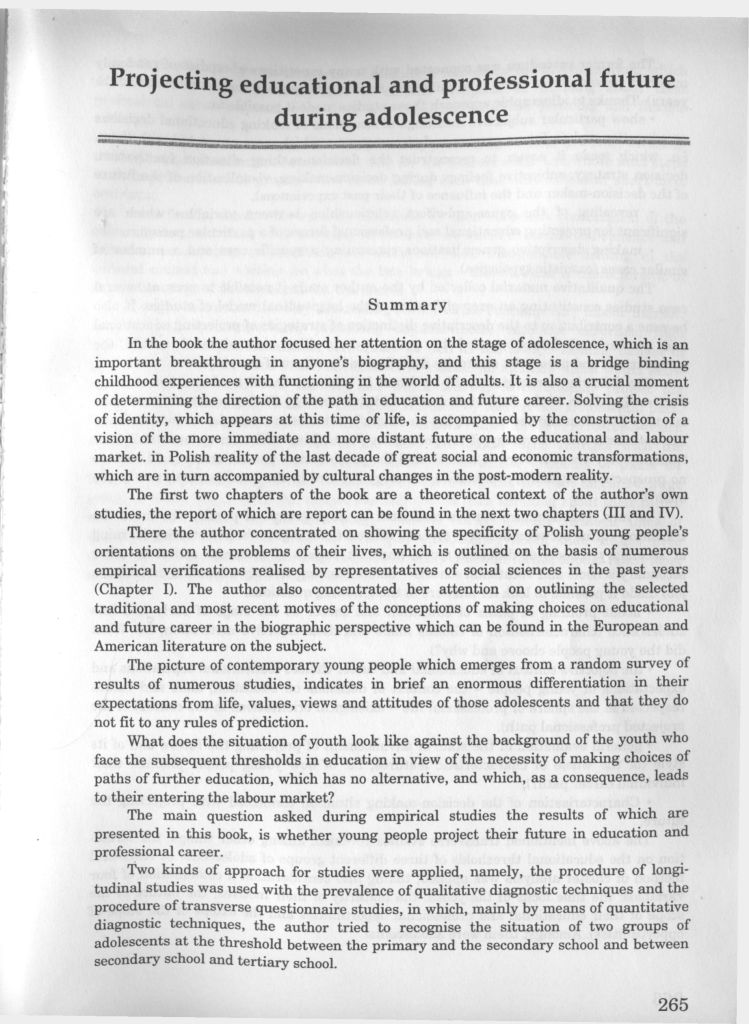265 (24)

Projecting educational and professional futurę
during adolescence
Summary
In the book the author focused her attention on the stage of adolescence, which is an important breakthrough in anyone’s biography, and this stage is a bridge binding childhood experiences with functioning in the world of adults. It is also a crucial moment of determining the direction of the path in education and futurę career. Solving the crisis of identity, which appears at this time of life, is accompanied by the construction of a vision of the morę immediate and morę distant futurę on the educational and labour market, in Polish reality of the last decade of great social and economic transformations, which are in tum accompanied by cultural changes in the post-modem reality.
The first two chapters of the book are a theoretical context of the authoris own studies, the report of which are report can be found in the next two chapters (III and IV).
There the author concentrated on showing the specificity of Polish young people’s orientations on the problems of their hves, which is outlined on the basis of numerous empirical verifications realised by representatives of social Sciences in the past years (Chapter I). The author also concentrated her attention on outlining the selected traditional and most recent motives of the conceptions of making choices on educational and futurę career in the biographic perspective which can be found in the European and American literaturę on the subject.
The picture of contemporary young people which emerges from a random survey of results of numerous studies, indicates in brief an enormous differentiation in their expectations from life, values, views and attitudes of those adolescents and that they do not fit to any rules of prediction.
What does the situation of youth look like against the background of the youth who face the subsequent thresholds in education in view of the necessity of making choices of paths of further education, which has no alternative, and which, as a conseąuence, leads to their entering the labour market?
The main question asked during empirical studies the results of which are presented in this book, is whether young people project their futurę in education and professional career.
Two kinds of approach for studies were applied, namely, the procedurę of longi-tudinal studies was used with the prevalence of qualitative diagnostic techniques and the procedurę of transverse questionnaire studies, in which, mainly by means of quantitative diagnostic techniques, the author tried to recognise the situation of two groups of adolescents at the threshold between the primary and the secondary school and between secondary school and tertiary school.
265
Wyszukiwarka
Podobne podstrony:
A/CN.9/61 Name Present position Educational and Professional ąualifications Prof essional
A/CN.9/61 Page 63 Educational and Professional ąualifications Professional experience Fields of
ones) and for the information system attached to the Ministery of Education and Science. One can say
24 Project Management for PhDs est to plan well. The new work, for example setting up one’s own busi
UHAM041 24 * UNDERSTANDING HEADACHES AND M IG RAI N ES is in intensity rather than quality. In all o
55541 IMG#24 16 AssocMdw Principłes and Democratic Reform oonsaderabłe part in the course of public
Kruszelnicki P. 2012. Tracking and rłsk of abdominal obesity in the adolescence period in children a
FACULTY OF MANAGEMENT 4. Educational and social environment: 4.1. LIBRARIES: Main Library: The Libra
58 contrast to this androcratic and patriarchal order we find, in the oldest pre-Semitic and pre-Ind
STEPHEN (J. M.), BLABER (F.L.S.) 1976 ; The food and feeding ecology of Mugilidae in the St. Lucia&n
262 DESTYLERN1A „POLMOS" W KRAKOWIE S.A. ... and of course distillery, already in the late fift
cp 34 What inspiration U thcrc to betler and dcancr methods of life. in the spectaclc of a musde-bou
więcej podobnych podstron